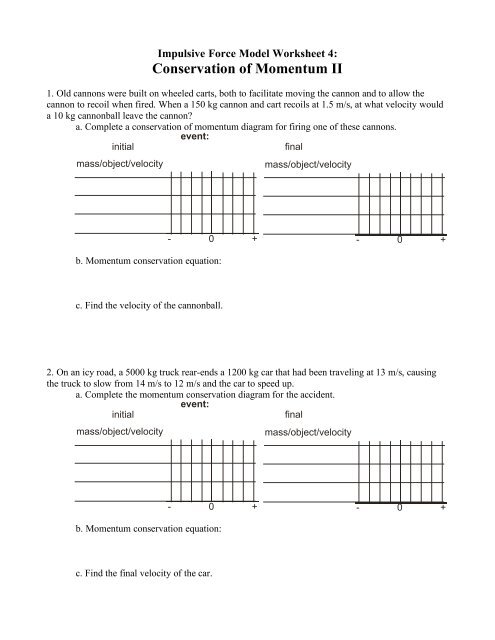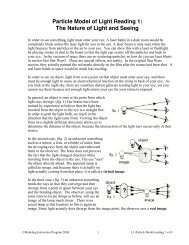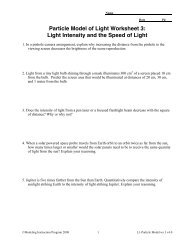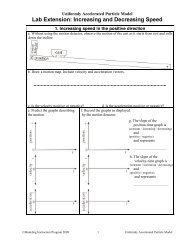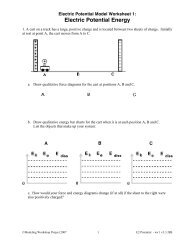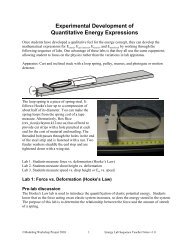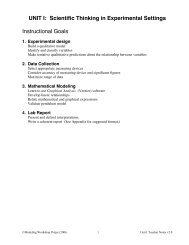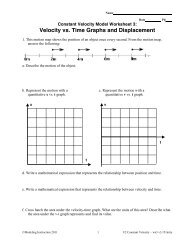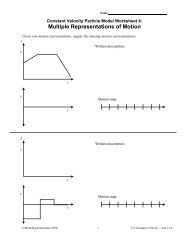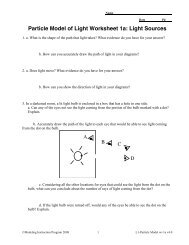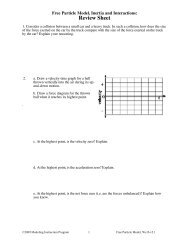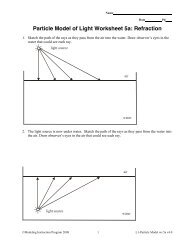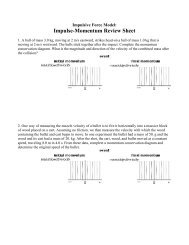Worksheet 4: Conservation of Momentum II - Modeling Physics
Worksheet 4: Conservation of Momentum II - Modeling Physics
Worksheet 4: Conservation of Momentum II - Modeling Physics
You also want an ePaper? Increase the reach of your titles
YUMPU automatically turns print PDFs into web optimized ePapers that Google loves.
Impulsive Force Model <strong>Worksheet</strong> 4:<br />
<strong>Conservation</strong> <strong>of</strong> <strong>Momentum</strong> <strong>II</strong><br />
1. Old cannons were built on wheeled carts, both to facilitate moving the cannon and to allow the<br />
cannon to recoil when fired. When a 150 kg cannon and cart recoils at 1.5 m/s, at what velocity would<br />
a 10 kg cannonball leave the cannon<br />
a. Complete a conservation <strong>of</strong> momentum diagram for firing one <strong>of</strong> these cannons.<br />
event:<br />
initial<br />
final<br />
mass/object/velocity<br />
mass/object/velocity<br />
- 0 +<br />
<strong>Momentum</strong> conservation equation:<br />
b. <strong>Momentum</strong> conservation equation:<br />
- 0 +<br />
c. Find the velocity <strong>of</strong> the cannonball.<br />
2. On an icy road, a 5000 kg truck rear-ends a 1200 kg car that had been traveling at 13 m/s, causing<br />
the truck to slow from 14 m/s to 12 m/s and the car to speed up.<br />
a. Complete the momentum conservation diagram for the accident.<br />
event:<br />
initial<br />
final<br />
mass/object/velocity<br />
mass/object/velocity<br />
- 0 +<br />
<strong>Momentum</strong> conservation equation:<br />
b. <strong>Momentum</strong> conservation equation:<br />
- 0 +<br />
c. Find the final velocity <strong>of</strong> the car.
3. During alpha decay, an atom ejects two protons and two neutrons (an alpha particle, which is also a<br />
helium nucleus). When radium-226 decays, it becomes radon-222 by ejecting an alpha particle.<br />
a. Complete the momentum conservation diagram for the radioactive decay <strong>of</strong> radium-226.<br />
(Recall from chemistry that the isotopic number <strong>of</strong> an element is related to its mass.)<br />
initial<br />
mass/object/velocity<br />
event:<br />
final<br />
mass/object/velocity<br />
- 0 +<br />
<strong>Momentum</strong> conservation equation:<br />
b. <strong>Momentum</strong> conservation equation:<br />
- 0 +<br />
c. How many times larger will the final velocity <strong>of</strong> the alpha particle be compared to the final<br />
velocity <strong>of</strong> the radon-222<br />
4. An apple falls from a tree.<br />
a. Complete a qualitative conservation <strong>of</strong> momentum diagram where the apple is initially<br />
attached to the tree and the final situation is just before the apple hits the ground.<br />
initial<br />
mass/object/velocity<br />
event:<br />
final<br />
mass/object/velocity<br />
- 0 +<br />
<strong>Momentum</strong> conservation equation:<br />
b. <strong>Momentum</strong> conservation equation:<br />
- 0 +
5. Airplanes maneuver on the<br />
ground by using thrust from their<br />
jets or propellers. A fully loaded,<br />
396,900 kg Boeing 747-400 gets a<br />
total <strong>of</strong> 1100 kiloNewtons <strong>of</strong> thrust<br />
from its jet engines. (Data from<br />
Boeing's website.) Take<strong>of</strong>f speed<br />
depends on a number <strong>of</strong> factors like<br />
air temperature, airplane weight,<br />
and airport elevation, but let us say<br />
that lift<strong>of</strong>f will occur at 170 mph.<br />
a. Determine the time the<br />
plane takes to go from 0 to 170<br />
mph. (1 mile = 1600 meters)<br />
b. Complete a conservation <strong>of</strong> momentum diagram showing how the initially stationary<br />
airplane gets to take<strong>of</strong>f speed.<br />
event:<br />
initial<br />
final<br />
mass/object/velocity<br />
mass/object/velocity<br />
- 0 +<br />
<strong>Momentum</strong> conservation equation:<br />
c. <strong>Momentum</strong> conservation equation:<br />
- 0 +<br />
d. Determine the momentum <strong>of</strong> the airplane at take<strong>of</strong>f.<br />
e. Calculate the impulse the plane receives from the engines during take<strong>of</strong>f.
f. What additional information would be needed to calculate the velocity <strong>of</strong> the exhaust gasses<br />
from the engines


